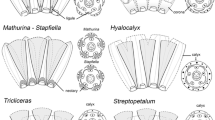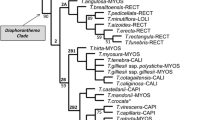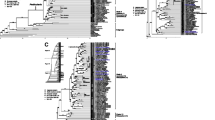Abstract
Schisandraceae are traditionally subdivided in two genera, Schisandra and Kadsura, based on differences in the organisation of the floral receptacle, the carpels, and the presence or absence of a ``pseudostigma''. Recently, phylogenetic analyses utilizing ITS sequence data and morphological data resulted in incongruent tree topologies, with the morphological trees suggesting monophyly of the two genera, whereas ITS trees did not resolve Schisandra and Kadsura as monophyletic clades. In the present paper we study seed morphology and leaf epidermal features of 22 species of Schisandraceae in order to provide additional data for a morphological data matrix. Seed morphological characters are highly homoplastic and do not yield further evidence for monophyly of the two genera. Instead, a number of characters appear to support sister group relationships between taxa within the genera, such as, for instance, for K. coccinea and K. scandens, both of which have large seeds along with a multi-layered mesotesta. Considering leaf epidermal characteristics, species of Kadsura were found to be consistently amphistomatic, whereas species of Schisandra are always hypostomatic. Phylogenetic analysis using the extended data matrix resulted in weakly supported Kadsura and Schisandra clades with five and four synapomorphies indicating monophyly of Kadsura and Schisandra, respectively. Fossils ascribed to Schisandraceae date back to the Late Cretaceous. These are tri-and hexacolpate pollen types displaying a combination of features found in modern Schisandraceae and partly also in Illiciaceae. Leaf remains from this period are poorly preserved and difficult to ascribe to Schisandraceae because of the lack of synapomorphies for the family. In the Early Cainozoic, leaf and seed remains from North America and Europe unambiguously belong to the family. Seeds from the Eocene of North America show some similarities to the modern Schisandra glabra from North America, while fossils from Europe show more similarities to modern Asian species.
Similar content being viewed by others
References
I Álvarez J. F Wendel (2003) ArticleTitleRibosomal ITS sequences and plant phylogenetic inference Molec. Phylogenet. Evol 29 417–434 Occurrence Handle14615184
A.-L Anderberg (1994) Atlas of seeds 4 Swedish Museum of Natural History Stockholm
Angiosperm Phylogeny Group (2003) An update of the Angiosperm Phylogeny Group classification for the orders and families of flowering plants: APG II. Bot. J. Linn. Soc. 141: 399–436.
C. D Bailey T. G Carr S. A Harris C. E Hughes (2003) ArticleTitleCharacterization of angiosperm nrDNA polymorphism, paralogy, and pseudogenes Molec. Phylogenet. Evol 29 435–455 Occurrence Handle14615185 Occurrence Handle1:CAS:528:DC%2BD3sXovVWntbY%3D
M Baranova (1992) ArticleTitlePrinciples of comparative stomatographic studies of flowering plants Bot. Rev 58 49–99
G Berggren (1969) Atlas of seeds 2 Swedish Museum of Natural History Stockholm
T. J Bones (1979) ArticleTitleAtlas of fossil fruits and seeds from north central Oregon Oregon Mus. Sci. Indust. Occas. Papers Nat. Sci 1 1–23
Bůžekč F Holý Z Kvaček (1996) ArticleTitleEarly Miocene flora of the Cypris Shale (western Bohemia) Acta Musei Nat. Pragae, ser. B, Hist. Nat 52 1–72
C. A Chmura (1973) ArticleTitleUpper Cretaceous (Campanian-Maastrichtian) angiosperm pollen from the western San Joaquin Valley, California, U.S.A Palaeontographica Abt. B 141 89–171
E. J. H Corner (1976) The seeds of dicotyledons. Vols. 1, 2 Cambridge University Press Cambridge
A Cronquist (1981) An integrated system of classification of flowering plants Columbia University Press New York
T Denk G Grimm K Stögerer M Langer V Hemleben (2002) ArticleTitleThe evolutionary history of Fagus in western Eurasia: Evidence from genes, morphology and the fossil record Pl. Syst. Evol 232 213–236 Occurrence Handle10.1007/s006060200044
T Denk G Grimm (2005) ArticleTitlePhylogeny and biogeography of Zelkova (Ulmaceae s.str.) as inferred from leaf morphology, ITS sequence data and the fossil record Bot. J. Linn. Soc 147 129–157 Occurrence Handle10.1111/j.1095-8339.2005.00354.x
J. A Doyle P. K Endress (2000) ArticleTitleMorphological phylogenetic analysis of basal angiosperms: Comparison and combination with molecular data Int. J. Plant Sci 161 IssueID6 suppl S121–S153 Occurrence Handle1:CAS:528:DC%2BD3cXos1Oqs70%3D
A. J Eames (1961) Morphology of the angiosperms McGraw-Hill New York
P. K Endress (2001) ArticleTitleThe flowers in extant basal angiosperms and inferences on ancestral flowers Int. J. Plant Sci 162 1111–1140 Occurrence Handle10.1086/321919
Ferguson D. K. (1971) The Miocene Flora of Kreuzau, Western Germany I. The leaf remains. Verh. Koninkl. Nederlandse Akad. Wetensch., Afd. Naturkunde, Tweede Reeks, 60, no. 1: 1–297.
R Florin (1920) ArticleTitleZur Kenntnis der jungtertiären Pflanzenwelt Japans Kongl. Svenska Vetenskapsakad. Handl 61 1–71
E. M Friis K. R Pedersen P. R Crane (2000) ArticleTitleReproductive structure and organization of basal angiosperms from the Early Cretaceous (Barremian or Aptian) of western Portugal Int. J. Plant Sci 161 IssueID6 Suppl S169–S182
H.-J Gregor (1981) ArticleTitleSchizandra geissertii nova spec. – ein exotisches Element im Elsässer Pliozän (Sessenheim, Brunssumien) Mitteil. Badischen Landesver. Naturk. Natursch 12 241–247
S Guo (1984) ArticleTitleLate Cretaceous plants from the Sunghuajiang-Liaohe Basin, Northeast China Acta Palaeont. Sin 23 85–90
G Hao M. L Chye R. M. K Saunders (2001) ArticleTitleA phylogenetic analysis of the Schisandraceae based on morphology and nuclear ribosomal ITS sequences Bot. J. Linn. Soc 135 401–411 Occurrence Handle10.1006/bojl.2000.0420
G Hao R. M. K Saunders M. L Chye (2000) ArticleTitleA phylogenetic analysis of the Illiciaceae based on sequences of internal transcribed spacers (ITS) of nuclear ribosomal DNA Pl. Syst. Evol 223 81–90 Occurrence Handle10.1007/BF00985328 Occurrence Handle1:CAS:528:DC%2BD3cXlvFWgt7g%3D
Y Hayashi (1963) ArticleTitleThe embryology of the family Magnoliaceae s. l. II. Megasporogenesis, female gametophyte and embryogeny of Schisandra repanda Radlkofer and Kadsura japonica Dunal Sci. Rep. Tôhoku Univ. Ser. Biol 29 403–411
A Igersheim P. K Endress (1997) ArticleTitleGynoecium diversity and systematics of the Magnoliales and winteroids Bot. J. Linn. Soc 124 213–271 Occurrence Handle10.1006/bojl.1997.0102
H Jähnichen (1976) ArticleTitleSchisandraceae und Illiciaceae als holarktische und subtropische Florenelemente im mitteleuropäischen Alttertiär Abh. Zentr. Geol. Inst. Paläontol 26 151–197
B. M Johri K. B Ambegaokar P. S Srivastava (1992) Comparative embryology of angiosperms Springer Berlin
H Keng (1993) Schisandraceae K. Kubitzki J. G. Rohwer V. Bittrich (Eds) The families and genera of vascular plants. II Flowering plants - Dicotyledons. Magnoliid, Hamamelid and Caryophyllid Families Springer Berlin 589–592
E Knobloch (1978) ArticleTitleDie untermiozäne Flora von Safov in Südmähren Vestn. Ústredn. Geol 53 153–162
Leaf Architecture Working Group (1999) Manual of Leaf Architecture - morphological description and categorization of dicotyledonous and netveined monocotyledonous angiosperms by Leaf Architecture Working Group. 65pp. Leaf Architecture Working Group c/o Scott Wing, Department of Paleobiology, Smithsonian Institution, 10th St. & Constitution Ave., N.W. Washington, DC 20560-0121.
W. P Maddison D. R Maddison (1992) MacClade: Analysis of phylogeny and character evolution. Version 3.0 Sinauer Associates Sunderland, Massachusetts
S. R Manchester (1994) ArticleTitleFruits and seeds of the Middle Eocene Nut Beds Flora, Clarno Formation, Oregon Palaeontogr. Amer 58 1–205
P. S Manos Z.-K Zhou C. H Cannon (2001) ArticleTitleSystematics of Fagaceae: Phylogenetic tests of reproductive trait evolution Int. J. Plant Sci 162 1361–1379 Occurrence Handle10.1086/322949
M Mayol J. A Rosselló (2001) ArticleTitleWhy nuclear ribosomal DNA spacers (ITS) tell different stories in Quercus Molec. Phylogenet. Evol 19 167–176 Occurrence Handle11341800 Occurrence Handle1:CAS:528:DC%2BD3MXjt1Gmsb8%3D
Melikian A. P. (1988). Illiciales. In: Takhtajan A. (ed.) Anatomia seminum comparativa. Vol. 2. Dicotyledons: Magnoliidae, Ranunculidae. Izd. Nauka, Leningrad. (In Russian), pp. 48–50.
C. R Metcalfe (1987) Anatomy of the dicotyledons, vol. 3, Magnoliales, Illiciales, and Laurales Clarendon Press Oxford 224
Oh I.-C., Denk T. (2001) Seed and leaf character evolution in the monogeneric basal angiosperm family Illiciaceae. International Symposium Deep Morphology: p. 61. 19–21 October, 2001, Vienna, Austria.
I.-C Oh T Denk E. M Friis (2003) ArticleTitleEvolution of Illicium (Illiciaceae): Mapping morphological characters on the molecular tree Pl. Syst. Evol 240 175–209 Occurrence Handle10.1007/s00606-003-0022-1
J. L Panero P. D Aranda (1998) ArticleTitleThe family Schisandraceae – a new record for the flora of Mexico Brittonia 50 87–90
Y. L Qiu J Lee F Bernasconi-Quadroni D. E Soltis P. S Soltis M Zanis E. A Zimmer Z Chen V Savolainen M. W Chase (2000) ArticleTitlePhylogeny of basal angiosperms: Analyses of five genes from three genomes Int. J. Plant Sci 161 IssueID6 suppl. S3–S27 Occurrence Handle1:CAS:528:DC%2BD3cXos1Oqs74%3D
Y. L Qiu J Lee B. A Whitlock F Bernasconi-Quadroni O Dombrovska (2001) ArticleTitleWas the ANITA rooting of the angiosperm phylogeny affected by long-branch attraction Mol. Biol. Evol 18 1745–1753 Occurrence Handle11504854 Occurrence Handle1:CAS:528:DC%2BD3MXmt12hsrg%3D
F. B Sampson (2000) ArticleTitlePollen diversity in some modern magnoliids Int. J. Plant Sci 161 IssueID6 Suppl S193–S210
R. M. K Saunders (1998) ArticleTitleMonograph of Kadsura (Schisandraceae) Syst. Bot. Monogr 54 1–106
R. M. K Saunders (2000) ArticleTitleMonograph of Schisandra (Schisandraceae) Syst. Bot. Monogr 58 1–146
A. C Smith (1947) ArticleTitleThe families Illiciaceae and Schisandraceae Sargentia 7 1–224
D. L Swofford (1993) PAUP*: Phylogenetic analysis using parsimony version 3.1.1. Computer program distributed through the Illinois Natural History Survey Champaign USA
A Takhtajan (1969) Flowering plants: Origin and dispersal Oliver and Boyd Ltd. Edinburgh
B. H Tiffney S. R Manchester (2001) ArticleTitleThe use of geological and paleontological evidence in evaluating plant phylogeographic hypotheses in the Northern Hemisphere Tertiary Int. J. Plant Sci 162 IssueID6 Suppl S3–S17
G. R Upchurch (1984) ArticleTitleCuticle evolution in Early Cretaceous angiosperms from the Potomac Group of Virginia and Maryland Ann. Missouri. Bot. Gard 71 522–550
M. J Zanis D. E Soltis P. S Soltis S Mathews M. J Donoghue (2002) ArticleTitleThe root of the angiosperms revisited Proc. Natl. Acad. Sci 99 6848–6853 Occurrence Handle12011443 Occurrence Handle10.1073/pnas.092136399 Occurrence Handle1:CAS:528:DC%2BD38XjvFCrurw%3D
Author information
Authors and Affiliations
Corresponding author
Rights and permissions
About this article
Cite this article
Denk, T., Oh, I.C. Phylogeny of Schisandraceae based on morphological data: evidence from modern plants and the fossil record. Plant Syst. Evol. 256, 113–145 (2005). https://doi.org/10.1007/s00606-005-0327-3
Received:
Accepted:
Published:
Issue Date:
DOI: https://doi.org/10.1007/s00606-005-0327-3




